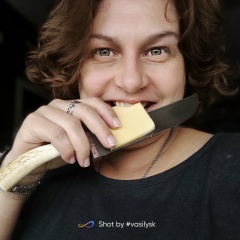(4/6) Несмотря на то, что укрепления на месте Старой крепости появились еще в пятом веке, каменную форму они приняли в веке тринадцатом. Наибольшая перестройка крепости произошла во второй половине пятнадцатого века – тогда она была в составе Молдавского княжества; а еще век спустя понадобился новый «ремонт» – устранить последствия штурма крепости поляками. Проще говоря, Хотинская крепость является молдавской. И вблизи она совсем не крошечная. А укрепления отнюдь не шуточные.
Сами посмотрите: с одной стороны – спуск к Днестру, который нужно было укреплять для защиты от нападения со стороны реки; с другой – овраг, из которого вырастает как минимум пятидесятиметровая каменная кладка. Перепад высоты между внешней стеной и внутренним двором поражает – разница раза в два, если не больше. Стены крепости обрамляют четыре башни, причем самая мощная, Северная, также стоит на краю глубокого оврага. Окружающие замок холмы и овраги вообще страшная вещь – оступиться или потерять из вида человека – раз плюнуть. Воспоминаний о стрессе с той прогулки у меня не меньше, чем восторгов.
Еще двумя внешними изюминками крепости являются необычные, выложенные из красного кирпича орнаменты, популярные в молдавской архитектуре, а также огромное мокрое пятно на западной стене. Это пятно меня очень позлило во время поездки – ну как так, потомки, такую красоту не уберегли, наверняка это мокрое пятно скоро все размоет и крепость начнет разрушаться. Но оказывается, это пятно «украшает» стену уже минимум пару веков, размер его не меняется, а появление успело обрасти тайнами и легендами. Наиболее правдоподобной звучит версия о лопнувших в крепостном подвале бочках с олифой. Другие варианты более «кровожадные» - это либо слезы узников турецкого плена, либо замурованной в стене девушки. Выбирайте, что вам ближе. А по расположению пятна на стене зацените, где находится подвал с внутренней стороны крепости.
Хотин, Украина, август 2016 / Khotyn, Ukraine, August 2016
#путешествиятормознутогокарпа #Хотин #Украина #Ка́мяне́цьПоді́льськи #Україна #Khotyn #Ukraine #travel #Хотинскаякрепость #KhotynFortress #Хотинськафортеця
Сами посмотрите: с одной стороны – спуск к Днестру, который нужно было укреплять для защиты от нападения со стороны реки; с другой – овраг, из которого вырастает как минимум пятидесятиметровая каменная кладка. Перепад высоты между внешней стеной и внутренним двором поражает – разница раза в два, если не больше. Стены крепости обрамляют четыре башни, причем самая мощная, Северная, также стоит на краю глубокого оврага. Окружающие замок холмы и овраги вообще страшная вещь – оступиться или потерять из вида человека – раз плюнуть. Воспоминаний о стрессе с той прогулки у меня не меньше, чем восторгов.
Еще двумя внешними изюминками крепости являются необычные, выложенные из красного кирпича орнаменты, популярные в молдавской архитектуре, а также огромное мокрое пятно на западной стене. Это пятно меня очень позлило во время поездки – ну как так, потомки, такую красоту не уберегли, наверняка это мокрое пятно скоро все размоет и крепость начнет разрушаться. Но оказывается, это пятно «украшает» стену уже минимум пару веков, размер его не меняется, а появление успело обрасти тайнами и легендами. Наиболее правдоподобной звучит версия о лопнувших в крепостном подвале бочках с олифой. Другие варианты более «кровожадные» - это либо слезы узников турецкого плена, либо замурованной в стене девушки. Выбирайте, что вам ближе. А по расположению пятна на стене зацените, где находится подвал с внутренней стороны крепости.
Хотин, Украина, август 2016 / Khotyn, Ukraine, August 2016
#путешествиятормознутогокарпа #Хотин #Украина #Ка́мяне́цьПоді́льськи #Україна #Khotyn #Ukraine #travel #Хотинскаякрепость #KhotynFortress #Хотинськафортеця
(4/6) Despite the fact that the fortifications on the site of the Old Fortress appeared in the fifth century, they took the stone form in the thirteenth century. The largest restructuring of the fortress occurred in the second half of the fifteenth century - then it was part of the Moldavian principality; and a century later, a new “repair” was needed - to eliminate the consequences of the assault on the fortress by the Poles. Simply put, the Khotyn fortress is Moldavian. And near it is not at all tiny. And fortifications are by no means comic.
See for yourself: on the one hand - the descent to the Dniester, which had to be strengthened to protect against attack from the river; on the other, a ravine from which at least fifty-meter masonry grows. The height difference between the outer wall and the courtyard is striking - the difference is two times, if not more. The walls of the fortress are framed by four towers, the most powerful, North, also standing on the edge of a deep ravine. The hills and ravines surrounding the castle are generally a terrible thing - to stumble or lose sight of a person - just spit. I have no less memories of stress from that walk than enthusiasm.
Another two external highlights of the fortress are unusual ornaments lined with red bricks, popular in Moldavian architecture, as well as a huge wet spot on the western wall. This spot made me very angry during the trip - well, the descendants didn’t save such beauty, for sure this wet spot will soon wash out everything and the fortress will begin to collapse. But it turns out that this spot "decorates" the wall for at least a couple of centuries, its size does not change, and the appearance has managed to acquire secrets and legends. The most plausible version is the version of barrels with drying oil that burst in the basement. Other options are more “bloodthirsty” - this is either the tears of prisoners of Turkish captivity, or a girl walled up in the wall. Choose what is closer to you. And by the location of the stains on the wall, check out where the basement is located on the inside of the fortress.
Khotyn, Ukraine, August 2016 / Khotyn, Ukraine, August 2016
#travelbrake #Khotin #Ukraine #KamyanyetsPodilsky #Ukraine #Khotyn #Ukraine #travel #Khotyn fortress #KhotynFortress #Khotinskaforte
See for yourself: on the one hand - the descent to the Dniester, which had to be strengthened to protect against attack from the river; on the other, a ravine from which at least fifty-meter masonry grows. The height difference between the outer wall and the courtyard is striking - the difference is two times, if not more. The walls of the fortress are framed by four towers, the most powerful, North, also standing on the edge of a deep ravine. The hills and ravines surrounding the castle are generally a terrible thing - to stumble or lose sight of a person - just spit. I have no less memories of stress from that walk than enthusiasm.
Another two external highlights of the fortress are unusual ornaments lined with red bricks, popular in Moldavian architecture, as well as a huge wet spot on the western wall. This spot made me very angry during the trip - well, the descendants didn’t save such beauty, for sure this wet spot will soon wash out everything and the fortress will begin to collapse. But it turns out that this spot "decorates" the wall for at least a couple of centuries, its size does not change, and the appearance has managed to acquire secrets and legends. The most plausible version is the version of barrels with drying oil that burst in the basement. Other options are more “bloodthirsty” - this is either the tears of prisoners of Turkish captivity, or a girl walled up in the wall. Choose what is closer to you. And by the location of the stains on the wall, check out where the basement is located on the inside of the fortress.
Khotyn, Ukraine, August 2016 / Khotyn, Ukraine, August 2016
#travelbrake #Khotin #Ukraine #KamyanyetsPodilsky #Ukraine #Khotyn #Ukraine #travel #Khotyn fortress #KhotynFortress #Khotinskaforte








У записи 1 лайков,
0 репостов,
60 просмотров.
0 репостов,
60 просмотров.
Эту запись оставил(а) на своей стене Анастасия Карпова






















